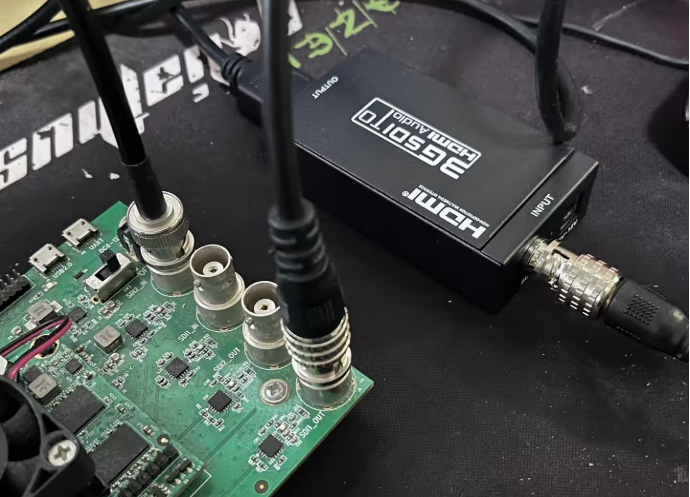
Discussing the Application of FPGA in Video Encoding
Global electronic component supplier AMPHEO PTY LTD: Rich inventory for one-stop shopping. Inquire easily, and receive fast, customized solutions and quotes.
Field-Programmable Gate Arrays (FPGAs) are highly customizable hardware platforms that have been increasingly adopted in video encoding due to their flexibility, parallel processing capabilities, and power efficiency. They play a crucial role in accelerating video encoding processes, especially for demanding applications like live streaming, cloud-based video processing, and AI-enhanced video analytics.
1. Why Use FPGA for Video Encoding?

Video encoding is computationally intensive because it involves compressing video data to reduce bandwidth while preserving quality. FPGAs offer unique advantages in this space:
- Parallel Processing: FPGAs can handle multiple tasks simultaneously by leveraging parallel data paths, a crucial requirement for video encoding.
- Customization: Developers can implement highly specific algorithms, such as custom H.264, H.265/HEVC, or AV1 encoders, optimized for a particular application.
- Low Latency: FPGAs provide real-time processing, which is essential for live video streaming, video conferencing, and broadcasting.
- Energy Efficiency: Compared to general-purpose CPUs or GPUs, FPGAs achieve better power-performance ratios.
- Reconfigurability: FPGAs can be updated or reprogrammed to support new encoding standards without replacing the hardware.
2. Applications of FPGA in Video Encoding
a. Real-Time Video Streaming
- FPGAs are ideal for encoding live video streams in real time. For instance, streaming services use FPGA-based hardware accelerators to encode video into multiple formats and bitrates (adaptive bitrate streaming).
- FPGA encoders can support high-resolution formats like 4K and 8K video with low latency, critical for live events.
b. Cloud Video Processing
- Companies such as AWS, Microsoft Azure, and Google Cloud integrate FPGA-based hardware accelerators (e.g., AWS F1 Instances) to process and encode videos in the cloud.
- FPGAs offload encoding workloads from CPUs, reducing costs and enabling scalable video delivery in cloud platforms.
c. Broadcast and Video Surveillance
- In video surveillance systems, FPGA-based encoders process multiple camera feeds simultaneously. FPGAs efficiently encode videos at edge devices, reducing bandwidth for data transmission.
- For TV broadcasters, FPGA accelerators encode high-definition video for transmission over satellite or terrestrial networks.
d. AI-Assisted Video Encoding
- FPGAs are integrated with AI-based tools for intelligent encoding decisions, such as adaptive quality adjustments, noise reduction, and scene-aware encoding.
- AI and ML algorithms can be implemented directly on FPGA hardware to optimize video compression and quality.
e. Video Conferencing
- Video conferencing platforms demand low-latency, real-time video encoding. FPGA-based accelerators can ensure smooth video delivery with minimal delays, even over constrained network conditions.
3. Encoding Standards Supported by FPGA
FPGAs can implement various video compression standards efficiently, including:
- H.264/AVC: Widely used for HD and Full HD video compression.
- H.265/HEVC: Supports high-resolution 4K/8K encoding with significant bandwidth savings.
- VP9/AV1: Modern open-source codecs optimized for web streaming and low-bitrate scenarios.
- VVC (H.266): Emerging standard for ultra-high-definition video compression.
4. Advantages Over Traditional Architectures
- CPU: While general-purpose CPUs can encode video, they struggle with the parallelism required for high-resolution, high-speed encoding. FPGAs outperform CPUs in terms of throughput and energy efficiency.
- GPU: GPUs offer better parallelism than CPUs, but they are power-hungry and less efficient for specialized tasks. FPGAs achieve similar performance at lower power.
- ASIC: ASICs are fixed-function hardware chips optimized for video encoding but lack reconfigurability. FPGAs bridge the gap by offering performance close to ASICs while remaining flexible.
5. Challenges of FPGA for Video Encoding
- Development Complexity: Programming FPGAs requires specialized skills in hardware description languages (HDLs) like VHDL/Verilog or higher-level frameworks like HLS (High-Level Synthesis).
- Higher Initial Cost: FPGA hardware can be expensive upfront, although this is offset by lower operational costs.
- Resource Constraints: Encoding ultra-high-definition video requires significant FPGA resources, which can limit performance in smaller devices.
6. Future Trends
- Edge AI and Video Processing: Combining FPGA with AI at edge devices for smart encoding, object recognition, and analytics in video streams.
- Support for Emerging Codecs: Continuous adaptation to new video compression standards like AV1 and VVC.
- Hybrid Architectures: Integration of FPGA with CPUs and GPUs to build hybrid video encoding systems for maximum performance.
- 5G and IoT Applications: Real-time video streaming and processing over 5G networks with FPGA-powered edge devices.
7. Conclusion
FPGAs are revolutionizing video encoding by providing real-time, energy-efficient, and highly parallel processing capabilities. Their flexibility to implement custom algorithms and support emerging video standards makes them ideal for live streaming, cloud-based video delivery, and edge AI applications. While there are challenges in terms of cost and complexity, the increasing demand for high-resolution video and low-latency applications ensures that FPGAs will play a significant role in future video processing systems.
Related Articles
- ·The best MCUs/MPUs for industrial humanoid robots
- ·What are the differences between FPGA and DSP processors for signal processing?
- ·How to become an FPGA engineer? Which FPGA board and program are suitable for beginners?
- ·How to Generate Low Clock Frequencies in FPGA?
- ·How to Use DDR Memory with FPGA for DSP Application?
- ·Application of Embedded Systems in Industrial Robots
- ·Application of Embedded Systems in Aerospace and Defense Fields
- ·Comparison of FPGA, ARM, STM32, and DSP Platforms
- ·Comparison of FPGA, CPLD, PLC, Microprocessor, Microcontroller & DSP
- ·What is the difference between SoC, FPGA, and ASIC?
